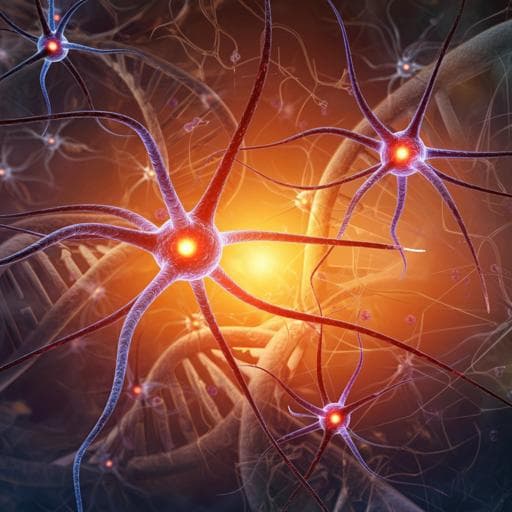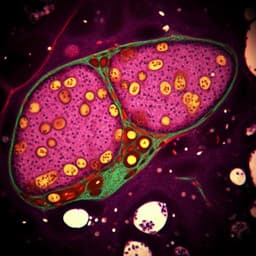
Medicine and Health
Targeting the hypothalamus for modeling age-related DNA methylation and developing OXT-GnRH combinational therapy against Alzheimer's disease-like pathologies in male mouse model
S. S. Usmani, H. Jung, et al.
This groundbreaking study by Salman Sadullah Usmani and colleagues uncovers the critical role of the hypothalamus in age-related DNA methylation and showcases the astonishing effectiveness of OXT-GnRH combinational therapy in combating Alzheimer's disease-like symptoms.
~3 min • Beginner • English
Introduction
The study investigates whether age-related epigenetic changes in the hypothalamus can inform strategies to address aging-related neurodegenerative diseases such as Alzheimer’s disease (AD). Prior work implicates neurogenic brain regions (hippocampal dentate gyrus, subventricular zone, and mediobasal hypothalamus) in long-term effects on brain aging and degeneration. The hypothalamus has been proposed to regulate systemic aging and physiology, with neuropeptides such as GnRH and OXT implicated. However, comparative data across limbic components are lacking. The authors hypothesize that age-related DNA methylation patterns in the hypothalamus differ from other limbic regions and that these changes converge on hypothalamic endocrine pathways (notably OXT and GnRH), offering therapeutic targets for AD. They therefore compare methylomes of hypothalamus, hippocampus, and olfactory bulb (OB) across young and middle age and evaluate OXT and GnRH as potential combinational therapy in an AD-like mouse model.
Literature Review
Foundational literature links DNA methylation to aging and the development of epigenetic clocks. Hypothalamic roles in systemic aging and physiology have been reported, including involvement of GnRH and OXT in aging-related processes. Adult neurogenesis in hippocampus and subventricular zone contributes to limbic functions and may influence neurodegeneration. Prior studies suggest oxytocin can attenuate Aβ deposition or cognitive deficits in milder AD-like models, while GnRH has been explored in cancer therapy and more recently in cognition for Down syndrome and dementia, but effects in AD and combinational OXT-GnRH therapy remain unclear. Methods for deconvolving cell-type heterogeneity in methylation data and pathway enrichment (e.g., Enrichr, STRING/Cytoscape) are established in the literature and inform the computational analyses.
Methodology
Design: Comparative epigenetic profiling and functional validation in mice. Brain regions: hypothalamus (HT), hippocampus (HC), olfactory bulb (OB). Ages: young (2 months) vs middle age (12 months for methylation; 15 months for qRT-PCR). Sex: male. Strains: C57BL/6 (aging analysis) and 5×FAD (AD-like model).
Epigenomics: Bisulfite oligonucleotide-captured sequencing (BOCS) targeting CG-rich regions (all annotated promoters, CG islands, shores ±2 kb, shelves ±2 kb from shores and ±4 kb from islands). DNA extraction, fragmentation (150–200 bp), library prep (SureSelectXT Methyl-Seq), capture, bisulfite conversion (EZ DNA Methylation-Gold), sequencing (MiSeq PE75 QC, NextSeq500 High PE75). QC with FastQC; trimming (BaseSpace MethylSeq v2.0.0; remove 3 nt from 5′ and 4 nt from 3′; adapter removal; Q>30 retained). Alignment to mm10 with Bismark/Bowtie2, >25M aligned reads/sample, 18–20× target coverage. Methylation calling via Bismark. Differential methylation analysis in R (v4.1.2) with MethylKit v1.20.0: DMCs using logistic regression, q<0.05 (SLIM FDR), absolute methylation difference ≥25%. DMRs defined as 500 bp windows (also 300–1000 bp considered) with >10% average methylation difference, q<0.05. Gene annotation from Gencode; mapping with BEDTools v2.30.0. Brain-region cellular composition assessed by reference-free deconvolution (DXM; dxm_estimateFracs) to estimate major cell-type proportions. Pathway analyses: Enrichr KEGG; protein interaction with Cytoscape/STRING (confidence >0.4).
Gene expression: qRT-PCR on hypothalamus (Oxt, Gnrh1) and hippocampus (Adcy3, Adcy5, Adcy7, Adcy9) from 2 vs 15-month C57BL/6 and 8-month 5×FAD vs WT males; β-actin reference; 2^-ΔΔCT; primer sequences provided. Statistics: Two-tailed unpaired t-tests for two-group comparisons; ANOVA with Tukey post-hoc for multi-group; normality assessed (Shapiro–Wilk, D’Agostino–Pearson, etc.); significance p<0.05.
Therapeutic testing: Male 5×FAD mice (9 months) received daily intranasal treatments for 2 months: OXT 50 ng, GnRH 5 ng, or combination vs vehicle. Behavioral assays post-treatment: open field (locomotion), grip strength, Y-maze (working memory), novel object recognition, social interaction, and Morris Water Maze (5-day training and probe; swimming speed control). Aβ pathology: brain immunostaining (Aβ antibody; Alexa Fluor 555; DAPI) in hippocampal CA1/CA3/DG, entorhinal cortex, mediobasal hypothalamus; imaging with Leica Stellaris 8 confocal; ImageJ quantification of plaque density.
Targeted promoter methylation after therapy: NGS-BSP of promoter subregions (between CG island and coding sequence) for Adcy genes in hippocampus from treated 5×FAD mice; DMC analysis for localized cytosine changes.
Ethics: IACUC-approved protocols at Albert Einstein College of Medicine. Data/code availability: GEO GSE276875; Figshare link for promoter data and raw images; GitHub repository for code.
Key Findings
- Young hypothalamus shows distinctly higher global DNA methylation than hippocampus and OB, with differences diminishing by middle age. Two-way ANOVA identified significant effects: tissue factor p = 0.030; age factor p < 0.001 (CG and CH averages across regions).
- Regional DMCs: At young age, HT vs HC and HT vs OB differences were more hypermethylation-biased; many regional differences (>60%) were lost by middle age for HT vs others, whereas HC vs OB lost ~40% of DMCs. Deconvolution suggested stable major cell-type proportions across ages, indicating compositional stability is unlikely to drive these changes.
- Age-dependent DMRs (500 bp windows): HT exhibited a balanced hyper-/hypomethylation pattern, whereas HC and OB showed hypermethylation bias. Across regions, 173 genes overlapped among age-related DMRs; hypomethylation bias among these was strongest in HT (hypo > hyper across 94 genes in HT, 60 in HC, 34 in OB). Enriched pathways included circadian rhythm/entrainment, reproductive/neuropeptide pathways (OXT and GnRH), endocrine and metabolic regulation, cardiovascular and immune functions.
- OXT and GnRH signaling: Pathway analyses in each region repeatedly implicated OXT and GnRH networks. Aging altered methylation of multiple OXT/GnRH pathway components in a region-specific manner. In hypothalamus, Oxt and Gnrh1 genes showed both hypo- and hypermethylated cytosines (promoter and gene body) by middle age. qRT-PCR showed significant transcriptional declines of Oxt (p = 0.009) and Gnrh1 with aging; both transcripts were also significantly reduced in 5×FAD hypothalamus vs WT (p < 0.001).
- Adenylate cyclases (Adcy): Promoter subregions in hippocampus displayed significant age-related methylation differences, e.g., Adcy3 CG island Δm = 1.42%, p = 0.009; proximal Δm = 1.06%, p = 0.044. Adcy5 proximal Δm = 0.65%, p = 0.048; CG island Δm = 0.62%, p = 0.010. Adcy7 proximal Δm = 0.87%, p < 0.001; distal Δm = 0.70%, p = 0.050. Adcy9 proximal Δm = 0.81%, p = 0.027. mRNA levels (15M vs 2M) decreased for Adcy3/5/7/9 (all p < 0.001). In 5×FAD vs WT hippocampus: Adcy3 (p = 0.986, ns), Adcy5 (p = 0.046), Adcy7 (p = 0.003), Adcy9 (p = 0.005) were altered. Post-therapy promoter-targeted sequencing revealed localized DMCs distinguishing OXT+GnRH from single treatments, despite no significant average methylation change in surveyed subregions.
- Therapeutic efficacy in 5×FAD: Two months of daily intranasal low-dose OXT+GnRH produced robust improvements across multiple behavioral domains (locomotion, grip strength, Y-maze, novel object recognition, social interaction; one-way ANOVA with Tukey yielded multiple significant p-values ≤ 0.047) and enhanced spatial learning/memory in Morris Water Maze (two-way ANOVA for training, and probe tests significant vs vehicle). Single-agent OXT or GnRH yielded modest or non-significant effects.
- Amyloid pathology: OXT+GnRH nearly completely reversed Aβ plaque burden across hippocampal CA1, CA3, DG, entorhinal cortex, and mediobasal hypothalamus (quantifications: all p < 0.001, except DG p = 0.002). Single agents were far less effective; GnRH alone reduced Aβ in mediobasal hypothalamus but not fornix bundle.
Discussion
The study addresses the hypothesis that the hypothalamus exhibits distinctive age-related DNA methylation dynamics that are informative for aging and aging-related diseases, and that these signals converge on hypothalamic endocrine networks, notably OXT and GnRH. The data show that the hypothalamus carries higher DNA methylation information in youth and undergoes distinct methylation/demethylation dynamics by middle age, with regional DMRs across limbic structures enriching hypothalamic regulatory pathways (circadian, OXT, GnRH). Declines in Oxt and Gnrh1 expression with aging and in an AD-like model support diminished hypothalamic neuropeptide signaling during disease-relevant windows. Functionally, combining OXT and GnRH produced synergistic therapeutic effects in aged 5×FAD males, outperforming single peptides by broadly rescuing behavior and substantially reducing Aβ burden across multiple brain regions. These findings link hypothalamic epigenetic aging features to actionable neuroendocrine targets, suggesting that combinational hypothalamic peptide therapy can address complex AD-like pathologies. The results support a broader view that hypothalamic epigenetic changes may underpin systemic and brain aging processes and that multi-node targeting within interconnected neuropeptide networks can yield superior efficacy.
Conclusion
This work establishes the hypothalamus as a distinctive epigenetic hub in early-to-mid aging and demonstrates that age-related methylation changes across limbic regions converge on hypothalamic endocrine pathways, especially OXT and GnRH. Transcriptional declines in Oxt and Gnrh1 accompany aging and AD-like states, motivating therapeutic testing. Intranasal OXT+GnRH combination therapy robustly ameliorated behavioral deficits and markedly reduced amyloid pathology in male 5×FAD mice, outperforming monotherapies with low doses and short duration. These findings provide a rationale for developing combinational hypothalamic peptide therapies for AD and potentially other aging-related neurodegenerative diseases. Future research should optimize dosing and timing, assess safety and off-target effects, include female models and diverse AD stages, expand brain region comparisons in epigenetic analyses, and test applicability to other disorders such as Parkinson’s disease.
Limitations
Computational analyses used n=3 per group, which limits power to detect additional DMCs/DMRs. Only three limbic regions were profiled; broader brain comparisons would strengthen generality. The epigenetic analyses were conducted in normal aging rather than directly in disease tissues; integrating AD samples could be more informative. Therapeutic studies focused on male mice only; female models were not tested. Dose and duration were chosen to reveal combinational advantages; optimization and safety profiling (off-target effects) are still needed. The targeted promoter methylation assessments post-therapy identified localized DMCs but did not show significant average methylation changes across surveyed subregions; deeper locus-specific functional validation is warranted.
Related Publications
Explore these studies to deepen your understanding of the subject.







